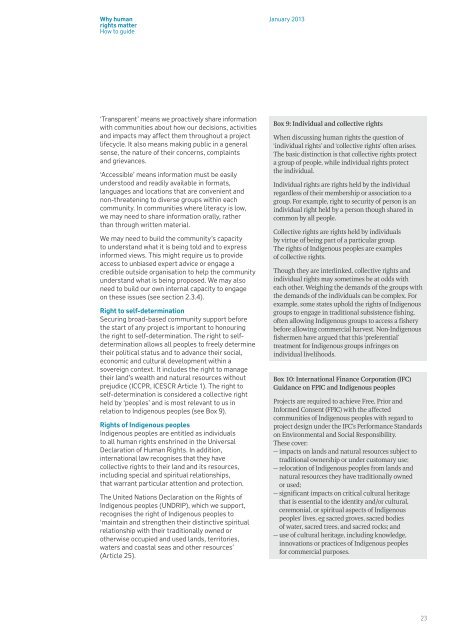Why human rights matter - Rio Tinto
Why human rights matter - Rio Tinto
Why human rights matter - Rio Tinto
Create successful ePaper yourself
Turn your PDF publications into a flip-book with our unique Google optimized e-Paper software.
<strong>Why</strong> <strong>human</strong><br />
<strong>rights</strong> <strong>matter</strong><br />
How to guide<br />
January 2013<br />
‘Transparent’ means we proactively share information<br />
with communities about how our decisions, activities<br />
and impacts may affect them throughout a project<br />
lifecycle. It also means making public in a general<br />
sense, the nature of their concerns, complaints<br />
and grievances.<br />
‘Accessible’ means information must be easily<br />
understood and readily available in formats,<br />
languages and locations that are convenient and<br />
non-threatening to diverse groups within each<br />
community. In communities where literacy is low,<br />
we may need to share information orally, rather<br />
than through written material.<br />
We may need to build the community’s capacity<br />
to understand what it is being told and to express<br />
informed views. This might require us to provide<br />
access to unbiased expert advice or engage a<br />
credible outside organisation to help the community<br />
understand what is being proposed. We may also<br />
need to build our own internal capacity to engage<br />
on these issues (see section 2.3.4).<br />
Right to self-determination<br />
Securing broad-based community support before<br />
the start of any project is important to honouring<br />
the right to self-determination. The right to selfdetermination<br />
allows all peoples to freely determine<br />
their political status and to advance their social,<br />
economic and cultural development within a<br />
sovereign context. It includes the right to manage<br />
their land’s wealth and natural resources without<br />
prejudice (ICCPR, ICESCR Article 1). The right to<br />
self-determination is considered a collective right<br />
held by ‘peoples’ and is most relevant to us in<br />
relation to Indigenous peoples (see Box 9).<br />
Rights of Indigenous peoples<br />
Indigenous peoples are entitled as individuals<br />
to all <strong>human</strong> <strong>rights</strong> enshrined in the Universal<br />
Declaration of Human Rights. In addition,<br />
international law recognises that they have<br />
collective <strong>rights</strong> to their land and its resources,<br />
including special and spiritual relationships,<br />
that warrant particular attention and protection.<br />
The United Nations Declaration on the Rights of<br />
Indigenous peoples (UNDRIP), which we support,<br />
recognises the right of Indigenous peoples to<br />
‘maintain and strengthen their distinctive spiritual<br />
relationship with their traditionally owned or<br />
otherwise occupied and used lands, territories,<br />
waters and coastal seas and other resources’<br />
(Article 25).<br />
Box 9: Individual and collective <strong>rights</strong><br />
When discussing <strong>human</strong> <strong>rights</strong> the question of<br />
‘individual <strong>rights</strong>’ and ‘collective <strong>rights</strong>’ often arises.<br />
The basic distinction is that collective <strong>rights</strong> protect<br />
a group of people, while individual <strong>rights</strong> protect<br />
the individual.<br />
Individual <strong>rights</strong> are <strong>rights</strong> held by the individual<br />
regardless of their membership or association to a<br />
group. For example, right to security of person is an<br />
individual right held by a person though shared in<br />
common by all people.<br />
Collective <strong>rights</strong> are <strong>rights</strong> held by individuals<br />
by virtue of being part of a particular group.<br />
The <strong>rights</strong> of Indigenous peoples are examples<br />
of collective <strong>rights</strong>.<br />
Though they are interlinked, collective <strong>rights</strong> and<br />
individual <strong>rights</strong> may sometimes be at odds with<br />
each other. Weighing the demands of the groups with<br />
the demands of the individuals can be complex. For<br />
example, some states uphold the <strong>rights</strong> of Indigenous<br />
groups to engage in traditional subsistence fishing,<br />
often allowing Indigenous groups to access a fishery<br />
before allowing commercial harvest. Non-Indigenous<br />
fishermen have argued that this ‘preferential’<br />
treatment for Indigenous groups infringes on<br />
individual livelihoods.<br />
Box 10: International Finance Corporation (IFC)<br />
Guidance on FPIC and Indigenous peoples<br />
Projects are required to achieve Free, Prior and<br />
Informed Consent (FPIC) with the affected<br />
communities of Indigenous peoples with regard to<br />
project design under the IFC’s Performance Standards<br />
on Environmental and Social Responsibility.<br />
These cover:<br />
— impacts on lands and natural resources subject to<br />
traditional ownership or under customary use;<br />
— relocation of Indigenous peoples from lands and<br />
natural resources they have traditionally owned<br />
or used;<br />
— significant impacts on critical cultural heritage<br />
that is essential to the identity and/or cultural,<br />
ceremonial, or spiritual aspects of Indigenous<br />
peoples’ lives, eg sacred groves, sacred bodies<br />
of water, sacred trees, and sacred rocks; and<br />
— use of cultural heritage, including knowledge,<br />
innovations or practices of Indigenous peoples<br />
for commercial purposes.<br />
23
















![[PDF] Community Development Toolkit - CommDev](https://img.yumpu.com/48616495/1/184x260/pdf-community-development-toolkit-commdev.jpg?quality=85)
